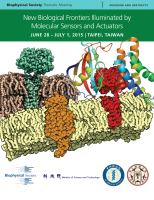

66
New Biological Frontiers Illuminated by Molecular Sensors and Actuators
Poster Abstracts
33-POS
Board 33
Localized Fluorescence Enhancement of Fluorescently Labelled DNA Strands Using Gold
Nanovoids.
Tracy Melvin
1
, Katrin Pechstedt
1
, SweZin Oo
1
, Gloria Silva
1,2
, Francesca Carpignano
1,2
,
Adnane Noual
1
, Peter Horak
1
.
1
University of Southampton, Highfield, United Kingdom,
2
Universita di Pavia, Pavia, Italy.
Nanoscale spherical voids embedded inside a gold film exhibit strong localised Mie plasmon
modes within the nanovoid volume.(1) The energy and electric field distribution of the localised
Mie modes can be tuned with void dimension. The fabrication of spherical nanovoids involves a
template method, in which the self-assembly of colloidal polymer nanospheres into a close-
packed hexagonal array is followed by electrochemical growth of gold around the spheres.(2)
The subsequent removal of the spheres leaves behind spherical gold nanaovoids. The use of gold
shifts the localised plasmon resonances to the visible part of the electro-magnetic spectrum,
crucial for fluorescence applications. The ability of surface plasmon polariton supporting,
nanostructured metal substrates to enhance the fluorescence intensity of nearby fluorescence
emitters is well-documented.(3, 4) Here, we present experimental results on the localised
enhanced fluorescence intensity of fluorescently labelled DNA strands stretched over a gold
nanovoid array, and interpret those results in light of the theoretically modelled localised Mie
plasmon modes supported by voids of the same dimensionality. These studies have been
extended to provide 3D structured gold nanovoids with pores through which the DNA strand is
to be transported. Free-standing 3D gold microcavities with a nanopore milled through the base
were designed for application using theoretical approaches so that the plasmon enhancement is
greatest at the pore.These new structures have been successfully fabricated and the results will be
presented.
1. Cole RM et al. 2007. Nanolett. 7: 2094-100
2. Mahajan S et al. 2006. Phys. Chem. Chem. Phys. 9: 104-9
3. Lakowicz JR. 2005. Anal. Biochem. 337: 171-94
4. Wu M et al. 2005. J. Fluorescence 15: 53-9

















